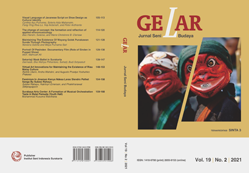Portrait of Pesinden Documentary Film: Role of Sinden in Puppet Show
Main Article Content
Abstract
Potret Posinden merupakan film dokumenter yang berusaha menunjukkan peran dan kedudukan sinden pada pertunjukan wayang kulit. Perubahan yang terjadi pada sinden saat ini membuat pertunjukan wayang kulit menjadi semakin menarik. Hal ini dibuktikan dengan fungsi sinden saat ini, bukan hanya menembang namun menjadi unsur penghibur. Sesekali jadi bahan lelucon pada saat limbukan dan goro-goro. Umumnya, sinden harus tampil dengan dandanan yang tidak biasa, sebab saat ini posisi sinden menghadap ke penonton. Sinden menjadi aspek penting di dalam setiap pertunjukan wayang kulit, dan hal itu tidak bisa dipisahkan. Film dokumenter ini menggunakan gaya expository, yaitu memiliki ciri berbicara langsung kepada penonton melalui on screen. Dokementer ini memanfaatkan penuturan dari narasumber atau subjek utama dalam menyampaikan informasi atau isi pada film.
Kata kunci: Film Dokumenter, Sinden, Wayang Kulit.
ABSTRACT
Portrait of Pesinden is a documentary film that attempts to show Sinden's role and position in shadow puppets performances. The changes that occurred in the current Sinden made shadow puppets performances even more enjoyable. This matter is evidenced by the current function of Sinden singing and being an entertainment element. Occasionally it becomes the material for a joke at the moment when it is “limbukan” and “goro-goro”. The general findings show that the Sinden must appear with unusual make-up because the position of the Sinden is facing the audience. In addition, Sinden is an essential aspect of every shadow puppet show, and it cannot be separated. To sum up, this documentary film uses an expository style characterized by speaking directly to the audience via the on-screen. So, the documentary uses the narrative from the primary source or subject in conveying information or content in the film.
Keywords: Documentary Film, Sinden; Shadow Puppets.
Downloads
Article Details
Copyright
Authors who publish with Gelar: Jurnal Seni Budaya agrees to the following terms:
- Authors retain copyright and grant the journal right of first publication with the work simultaneously licensed under a Creative Commons Attribution License (CC BY-SA 4.0) that allows others to share the work with an acknowledgment of the work's authorship and initial publication in this journal.
- Authors are able to enter into separate, additional contractual arrangements for the non-exclusive distribution of the journal's published version of the work (e.g., post it to an institutional repository or publish it in a book), with an acknowledgment of its initial publication in this journal.
- Authors are permitted and encouraged to post their work online (e.g., in institutional repositories or on their website) prior to and during the submission process, as it can lead to productive exchanges, as well as earlier and greater citation of published work.
References
Cohen, Matthew Isaac. 2019. “Wayang in Jaman Now: Reflexive Traditionalization and Local, National and Global Networks of Javanese Shadow Puppet Theatre.” Theatre Research International 44 (1): 40–57.
Gunawan, Eric. 2019. “The Concept of Shadow In Wayang Kulit Purwa Performance of Pedalangan Surakarta Style.” In Proceeding of International Conference on Visual Culture and Urban Life, 182–90.
Kusumaningrum, Anis. 2019. “Garap Sindhèn: Laras Téja, Ayak-Ayak Jalumampang Dan Playon Dalam Rangkaian Mrabot.” Institut Seni Indonesia Surakarta.
Li, Teng, and Weiqun Cao. 2021. “Research on a Method of Creating Digital Shadow Puppets Based on Parameterized Templates.” Multimedia Tools and Applications 80 (13): 20403–22.
Obadiah, Jason. 2021. “The Application of Binaural System on Virtual Reality Technology Through the Animation of Wayang Kulit Yogyakarta Performance.” In IMOVICCON Conference Proceeding, 2:87–94.
Önen, Ufuk. 2021. “The Voice as a Narrative Element in Documentary Films.” Resonance: The Journal of Sound and Culture 2 (1): 6–18.
Rahayu, Suryanti, and Budi Permadi Iskandar. 2021. “Study of Consumer Behavior on Tinting Wall Paint Product Purchasing Process: Case Study at RKM Soekarno Hatta, Bandung.” International Journal of Accounting 6 (35): 42–55.
Setiawan, Eko. 2020. “Nilai Filosofi Wayang Kulit Sebagai Media Dakwah.” Jurnal Al-Hikmah 18 (1): 33–50.
Susilo, Rachmad Kristiono Dwi, Agung Wijaya Kusuma, and Agung Wibowo. 2021. “Wayang as Local Communication Media in Building Public Awareness of Environmental Crisis.” The Journal of Society and Media 5 (2): 239–70.
Yusanto, Freddy, Dadang Rahmat Hidayat, Rahmat Edi Irawan, and Yasraf Amir Piliang. 2021. “Television Documentary Program Indonesia Bagus; A Semiotic Social Analysis.” Review of International Geographical Education Online 11 (5): 183–90.
